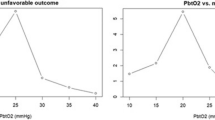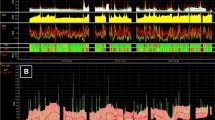Abstract
Background
In patients with severe traumatic brain injury (TBI), the depth and duration of cerebral hypoxia are independent predictors of outcome. This study aimed to evaluate the efficacy of brain oxygen-guided therapy in improving cerebral oxygenation and neurological outcome in severe TBI patients.
Methods
Thirty TBI patients had brain oxygen monitors placed contralateral to the side of mass lesions, or to the non-dominant side if injury was diffuse. The first 10 patients (Group 1, observational) had brain tissue oxygen (PbrO2) monitored, but not treated. The next 20 patients (Group 2, interventional) were treated according to brain tissue oxygen-guided algorithms aiming to improve cerebral oxygen availability. The 6-month neurological outcome of Group 2 patients was compared with that of Group 1 patients and with contemporary control patients (Group 3) treated without the use of brain oxygen monitoring.
Findings
The mean duration of brain hypoxic episodes (PbrO2 <15 mmHg) was 106 minutes in Group 1, and 34 minutes in Group 2 (p=0.01). Brain tissue oxygen was <15 mmHg for 10% of monitoring time in Group 1 and 2.8% in Group 2 (p=0.12). The peak incidence of cerebral hypoxic events in both groups occurred during post-injury day 5. The mean Injury Severity Score (ISS) of patients experiencing cerebral hypoxia was higher than that of patients without cerebral hypoxic episodes (33.7 vs 24.2, p=0.04). There was no statistically significant difference in neurological outcome between those patients treated with and those without brain oxygen-guided therapy.
Conclusions
In TBI patients, brain tissue oxygen-guided therapy is associated with decreased duration of episodes of cerebral hypoxia. Larger studies are indicated to determine the effects of this therapy on neurological outcome.




Similar content being viewed by others
References
Andrews PJ (2003) Potential end points of treatment after acute brain injury: should we be using monitors of metabolism? Curr Opin Crit Care 9:83–85. doi:10.1097/00075198-200304000-00001
Brain Trauma Foundation (2007) The American Association of Neurological Surgeons. The Joint Section on Neurotrauma and Critical Care. J Neurotrauma 24 [Suppl 1]:87–90. doi:10.1089/neu.2006.0058
Carmona Suazo JA, Maas AI, van den Brink WA, van Santbrink H, Steyerberg EW, Avezaat CJ (2000) CO2 reactivity and brain oxygen pressure monitoring in severe head injury. Crit Care Med 28:3268–3274. doi:10.1097/00003246-200009000-00024
Coles JP, Minhas PS, Fryer TD, Smielewski P, Aigbirihio F, Donovan T et al (2002) Effect of hyperventilation on cerebral blood flow in traumatic head injury: clinical relevance and monitoring correlates. Crit Care Med 30:1950–1959. doi:10.1097/00003246-200209000-00002
Coles JP, Steiner LA, Johnston AJ, Fryer TD, Coleman MR, Smieleweski P et al (2004) Does induced hypertension reduce cerebral ischaemia within the traumatized human brain? Brain 127:2479–2490. doi:10.1093/brain/awh268
Brain Trauma Foundation (2007) The American Association of Neurological Surgeons. The joint section on neurotrauma and critical care. J Neurotrauma 24(Suppl 1):S59–S64
Imberti R, Bellinzona G, Langer M (2002) Cerebral tissue PO2 and SjvO2 changes during moderate hyperventilation in patients with severe traumatic brain injury. J Neurosurg 96:97–102
Jennett B (1996) Epidemiology of head injury. J Neurol Neurosurg Psychiatry 60:362–369. doi:10.1136/jnnp.60.4.362
Johnston AJ, Steiner LA, Gupta AK, Menon DK (2003) Cerebral oxygen vasoreactivity and cerebral tissue oxygen reactivity. Br J Anaesth 90:774–786. doi:10.1093/bja/aeg104
Kiening KL, Hartl R, Unterberg AW, Schneider GH, Bardt T, Lanksch WR (1997) Brain tissue pO2-monitoring in comatose patients: implications for therapy. Neurol Res 19:233–240
Marshall LF, Eisenberg HM, Jane JA, Leurssen TG, Marmarou A, Foulkes MA et al (1991) A new classification of head injury based on computerized tomography. J Neurosurg 75:S14–S27
Meixensberger J, Jaeger M, Vath A, Dings J, Kunze E, Roosen K (2003) Brain tissue oxygen guided treatment supplementing ICP/CPP therapy after traumatic brain injury. J Neurol Neurosurg Psychiatry 74:760–764. doi:10.1136/jnnp.74.6.760
Menon DK (2003) Procrustes, the traumatic penumbra, and perfusion pressure targets in closed head injury. Anesthesiology 98:805–807. doi:10.1097/00000542-200304000-00002
Muizelaar JP, Marmarou A, Ward JD, Kontos HA, Choi SC, Becker DP et al (1991) Adverse effects of prolonged hyperventilation in patients with severe head injury: a randomized clinical trial. J Neurosurg 75:731–739
Pagano A, Barazzone-Argiroffo C (2003) Alveolar cell death in hyperoxia-induced lung injury. Ann N Y Acad Sci 1010:405–416. doi:10.1196/annals.1299.074
Steiner LA, Czosnyka M, Piechnik SK, Smielewski P, Chatfield D, Menon DK et al (2002) Continuous monitoring of cerebrovascular pressure reactivity allows determination of optimal cerebral perfusion pressure in patients with traumatic brain injury. Crit Care Med 30:733–738. doi:10.1097/00003246-200204000-00002
Teasdale GM, Pettigrew LE, Wilson JT, Murray G, Jennett B (1998) Analyzing outcome of treatment of severe head injury: a review and update on advancing the use of the Glasgow Outcome Scale. J Neurotrauma 15:587–597. doi:10.1089/neu.1998.15.587
Valadka AB, Gopinath SP, Contant CF, Uzura M, Robertson CS (1998) Relationship of brain tissue PO2 to outcome after severe head injury. Crit Care Med 26:1576–1581. doi:10.1097/00003246-199809000-00029
Van den Brink WA, van Santbrink H, Steyerberg EW, Avezaat CJ, Suazo JA, Hogesteeger C et al (2000) Brain oxygen tension in severe head injury. Neurosurgery 46:868–876. discussion 876–868. doi:10.1097/00006123-200004000-00018
Acknowledgements
The study was funded by a Victorian Trauma Foundation best practice grant. We acknowledge the efforts of the neurosurgical and ICU staff. We are grateful to Philip M. Lewis, John Iacono, Christina Lowe and Philippa Marks for efficient and reliable technical support and to Rachael Nevill for assistance with data collection.
Author information
Authors and Affiliations
Corresponding author
Rights and permissions
About this article
Cite this article
Adamides, A.A., Cooper, D.J., Rosenfeldt, F.L. et al. Focal cerebral oxygenation and neurological outcome with or without brain tissue oxygen-guided therapy in patients with traumatic brain injury. Acta Neurochir 151, 1399–1409 (2009). https://doi.org/10.1007/s00701-009-0398-y
Received:
Accepted:
Published:
Issue Date:
DOI: https://doi.org/10.1007/s00701-009-0398-y




